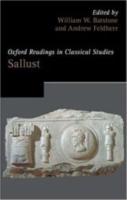
OUP (2020) h/b 494pp £100 (ISBN: 9780198790983)
Sallust was a prominent Roman historian, who lived from about 86–35 BC. He came to Rome from Amiternum as an ambitious outsider (novus homo) in search of a political career. He became a quaestor and, in 52 BC, a tribune of the plebs. In that role he made inflammatory speeches following the murder of Clodius Pulcher. He clashed with Cicero, who was defence counsel in the murder trial. The upshot of these events was that in 50 BC the censor, Appius Claudius Pulcher, expelled Sallust from the Senate. That was not the end of his career in public life. Sallust aligned himself with Caesar in the Civil War. He was given military commands but achieved little success. Even so Caesar rewarded his loyalty. He gave proconsular imperium to Sallust and made him governor of the newly created province of Numidia in North Africa. By all accounts Sallust practised extortion in that role and became a wealthy man. As a protégé of Caesar he escaped prosecution, but that was the end of his political ascent. He turned to writing history.
Sallust’s two principal surviving works are Bellum Catilinae (an account of Catiline’s conspiracy in 63 BC) and Bellum Jugurthinum (an account of the Jugurthine War in the late second century BC). He also wrote The Histories, which recounted the history of Rome from 78–7 BC, but only fragments of this text survive.
The present book forms part of the ‘Oxford Readings in Classical Studies’ series. It is a collection of papers and essays on Sallust, which have been published over past decades. In most instances they have been updated. These include accounts of Sallust’s life (as briefly summarised above) and detailed analysis of his works. A paper by Kurt Latte (chapter 2) deconstructs the narrative style and syntax. Sallust used archaisms and avoided familiar phrases. He was heavily influenced by Thucydides. Pairs of opposites frequently appear. Sallust was fond of chiasmus: eos laetos modo, modo pavidos animadvorteres—‘ you would have seen them happy now, now sad’.
Chapter 4 is a study of the use of imitation. Sallust was well read, and his writings contain many phrases or devices taken from earlier classical literature. This was not plagiarism. Like a modern author using Shakespearean language, he expected his readers to recognise the sources. A good example is Sallust’s description of Cato: ‘esse quam videri bonus malebat’—‘he preferred to be good rather than to seem good’. Aeschylus provides precisely the same description of Amphiaraus in Seven Against Thebes (line 592), in the messenger speech recounting Amphiaraus’ death. In Bellum Jugurthinum Sallust describes the training of young Numidians in horse riding and javelin throwing in a passage which consciously imitates Herodotus’ description of the Persians.
Four chapters are devoted to the Bellum Catilinae. Sallust wrote this some twenty years after the events in question. He was seeking to create a work of art, as well as a historical narrative. He had access to factual material now lost, including Cicero’s De consiliis suis. The whole piece is an indictment of the oligarchy in Rome and Catiline in particular. Sallust puts speeches in the mouths of the main figures only, which portray their characters. Caesar and Cato each have a single speech. Catiline has two speeches, one at the beginning and one at the end. One striking feature of the narrative is that the role of Cicero is played down and diminished at every opportunity. The orator is given no oration, as Edward Schwartz observes in chapter 5. As Batstone, one of the general editors, demonstrates, any conspiracy and certainly Catiline’s involves much that is uncertain. Sallust builds this uncertainty into his narrative.
Another four chapters focus on the Bellum Jugurthinum. Again, Sallust writes as a moral historian. He demonstrates how the disorder in North Africa extended to Rome. Bribery is a constant theme, including Jugurtha’s bribing of Roman nobles. The two principal characters are Jugurtha, the Numidian prince, and Marius, the novus homo who becomes consul and eventually defeats the Numidians at the battle of Cirta in 101 BC. The presentation of Marius is ambiguous: the reader is left to wonder whether he is a virtuous hero or a furtive intriguer. In chapter 10 (‘An Historical Fragment’) D.S. Levene demonstrates that Sallust gives his whole account the appearance of a fragment: Sallust does not mention Jugurtha’s subsequent imprisonment and death. As Levene pithily observes at page 274, ‘Jugurtha is a monograph about a Roman war, not a biography’.
This book is packed with detailed analysis. It is a valuable resource for students of ancient history and Latin literature. Anyone with an interest in the classics who is reading Sallust will find this a helpful companion. But as a work of in-depth scholarship, it is not for the general reader.
Rupert Jackson
